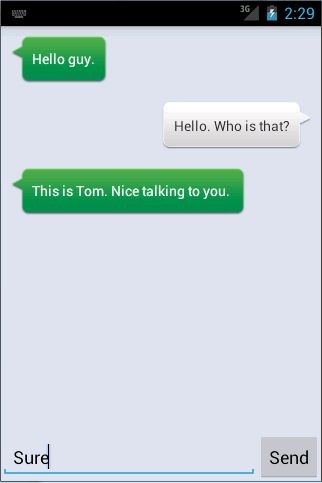我們制 作的 message_left.9.png 可以作為收到訊息的背景圖,那麼毫無疑問你還需要再製作一張 message_right.9.png 作為發出訊息的背景圖。
圖片都提供好了之後就可以開始編碼了,首先還是編寫主介面,修改 activity_main.xml
中的程式碼,如下所示:
<LinearLayout xmlns:android="http://schemas.android.com/apk/res/android"
xmlns:android1="http://schemas.android.com/apk/res/android"
android:layout_width="match_parent"
android:layout_height="match_parent"
android:background="#d8e0e8"
android:orientation="vertical" >
<ListView
android1:id="@+id/msg_list_view"
android1:layout_width="match_parent"
android1:layout_height="0dp"
android:layout_weight="1"
android:divider="#0000"
>
</ListView>
<LinearLayout
android1:layout_width="match_parent"
android:layout_height="wrap_content" >
<EditText
android:id="@+id/input_text"
android:layout_width="0dp"
android:layout_height="wrap_content"
android:layout_weight="1"
android:hint="Type somthing here"
android:maxLines="2" />
<Button
android:id="@+id/send"
android:layout_width="wrap_content"
android:layout_height="wrap_content"
android:text="Send" />
</LinearLayout>
</LinearLayout>
這裡在主介面中放置了一個 ListView 用於顯示聊天的訊息內容,又放置了一個 EditText 用於輸入訊息,還放置了一個 Button 用於傳送訊息。ListView 中用到了一個 android:divider 屬性,它可以指定 ListView 分隔線的顏色,這裡#0000 表示將分隔線設為透明色。其他用到 的所有屬性都是我們之前學過的,相信你理解起來應該不費力。
然後我們來定義訊息的實體類,新建 Msg,程式碼如下所示:
package com.example.uibestpractice; //defined message class public class Msg { //message content private String content; //message type private int type; //defined message type value public static final int TYPE_RECEIVE = 0; public static final int TYPE_SEND = 1; //defined constructor public Msg(String content , int type){ this.content = content; this.type = type; } //function use to getcontent public String getContent(){ return content; } //function use to gettype public int getType(){ return type; } }
Msg 類中只有兩個欄位,content 表示訊息的內容,type 表示訊息的型別。其中訊息型別 有兩個值可選,TYPE_RECEIVED 表示這是一條收到的訊息,TYPE_SENT 表示這是一條發 出的訊息。
接著來編寫 ListView 子項的佈局,新建 msg_item.xml,程式碼如下所示:
<?xml version="1.0" encoding="utf-8"?>
<LinearLayout xmlns:android="http://schemas.android.com/apk/res/android"
android:layout_width="match_parent"
android:layout_height="match_parent"
android:orientation="vertical"
android:padding="10dp" >
<LinearLayout
android:id="@+id/left_layout"
android:layout_width="wrap_content"
android:layout_height="wrap_content"
android:layout_gravity="left"
android:background="@drawable/message_left" >
<TextView
android:id="@+id/left_msg"
android:layout_width="wrap_content"
android:layout_height="wrap_content"
android:layout_gravity="center"
android:layout_margin="10dp"
android:textColor="#fff" />
</LinearLayout>
<LinearLayout
android:id="@+id/right_layout"
android:layout_width="wrap_content"
android:layout_height="wrap_content"
android:layout_gravity="right"
android:background="@drawable/message_right" >
<TextView
android:id="@+id/right_msg"
android:layout_width="wrap_content"
android:layout_height="wrap_content"
android:layout_gravity="center"
android:layout_margin="10dp"
android:textColor="#fff" />
</LinearLayout>
</LinearLayout>
這裡我們讓收到的訊息居左對齊,發出的訊息居右對齊,並且分別使用 message_left.9.png
和 message_right.9.png 作為背景圖。你可能會有些疑慮,怎麼能讓收到的訊息和發出的訊息 都放在同一個佈局裡呢?不用擔心,還記得我們前面學過的可見屬性嗎,只要稍後在程式碼中 根據訊息的型別來決定隱藏和顯示哪種訊息就可以了。
接下來需要建立 ListView 的介面卡類,讓它繼承自 ArrayAdapter,並將泛型指定為 Msg
類。新建類 MsgAdapter,程式碼如下所示:
package com.example.uibestpractice; import java.util.List; import android.content.Context; import android.view.LayoutInflater; import android.view.View; import android.view.ViewGroup; import android.widget.ArrayAdapter; import android.widget.LinearLayout; import android.widget.TextView; public class MsgAdapter extends ArrayAdapter<Msg> { private int resourceId; //context,listview sub item layoutid, listview data public MsgAdapter(Context context, int textViewResourceId, List<Msg> objects) { super(context, textViewResourceId, objects); // TODO Auto-generated constructor stub resourceId = textViewResourceId; } @Override public View getView(int position, View convertView, ViewGroup parent) { // TODO Auto-generated method stub //return super.getView(position, convertView, parent); //get current item Msg Msg msg = getItem(position); //through LayoutInflater for current sub item load layout; if(convertView == null){ convertView = LayoutInflater.from(getContext()).inflate(resourceId, parent,false); } //though viewhoder model to optimization listview //get layout object LinearLayout leftLinearLayout = ViewHolder.get(convertView, R.id.left_layout); LinearLayout rightLinearLayout = ViewHolder.get(convertView, R.id.right_layout); //though msg object type set linearlayout is visible if(msg.getType() == Msg.TYPE_RECEIVE){ //this is receive message , show left linearlayout and hide right linearlayout leftLinearLayout.setVisibility(View.VISIBLE); rightLinearLayout.setVisibility(View.GONE); //show receive message content TextView leftTextView = ViewHolder.get(convertView, R.id.left_msg); leftTextView.setText(msg.getContent()); } else if(msg.getType() == msg.TYPE_SEND){ //this is send message , show right linearlayout and hide right linearlayout leftLinearLayout.setVisibility(View.GONE); rightLinearLayout.setVisibility(View.VISIBLE); //show receive message content TextView rightTextView = ViewHolder.get(convertView, R.id.right_msg); rightTextView.setText(msg.getContent()); } return convertView; } }
以上程式碼你應該是非常熟悉了,和我們學習 ListView 那一節的程式碼基本是一樣的,只不 過在 getView()方法中增加了對訊息型別的判斷。如果這條訊息是收到的,則顯示左邊的消 息佈局,如果這條訊息是發出的,則顯示右邊的訊息佈局。
最後修改 MainActivity 中的程式碼,來為 ListView 初始化一些資料,並給傳送按鈕加入事 件響應,程式碼如下所示:
package com.example.uibestpractice; import java.util.ArrayList; import java.util.List; import android.app.Activity; import android.os.Bundle; import android.view.View; import android.view.Window; import android.widget.Button; import android.widget.EditText; import android.widget.ListView; public class MainActivity extends Activity { private List<Msg> msgList = new ArrayList<Msg>(); private MsgAdapter msgAdapter ; //defined message edittext control private EditText editText; //defined send button control private Button sendButton; //defined listview control; private ListView listView; @Override protected void onCreate(Bundle savedInstanceState) { super.onCreate(savedInstanceState); //hide app title requestWindowFeature(Window.FEATURE_NO_TITLE); setContentView(R.layout.activity_main); //init message data initMsgs(); //init MsgAdapter msgAdapter = new MsgAdapter(MainActivity.this, R.layout.msg_item, msgList); //get layout control editText = (EditText)findViewById(R.id.input_text); sendButton = (Button)findViewById(R.id.send); listView = (ListView)findViewById(R.id.msg_list_view); //give listview control set adapter; listView.setAdapter(msgAdapter); //set sendbutton onclick event sendButton.setOnClickListener(new View.OnClickListener() { @Override public void onClick(View v) { // TODO Auto-generated method stub //set listview control to show input message content String content = editText.getText().toString(); //if content is not null if(content.length() > 0){ //init msg object Msg msg = new Msg(content, Msg.TYPE_SEND); //add msg object to msglist data msgList.add(msg); //if new message is send, refresh listview control msgAdapter.notifyDataSetChanged(); //position to the listview last line listView.setSelection(msgList.size()); //clear input text content editText.setText(""); } } }); } //init message data private void initMsgs(){ Msg msg1 = new Msg("Hello guy.", Msg.TYPE_RECEIVE); msgList.add(msg1); Msg msg2 = new Msg("Hello. Who is that?", Msg.TYPE_SEND); msgList.add(msg2); Msg msg3 = new Msg("This is Tom. Nice talking to you. ", Msg.TYPE_RECEIVE); msgList.add(msg3); } }
在 initMsgs()方法中我們先初始化了幾條資料用於在 ListView 中顯示。然後在傳送按鈕
的點選事件裡獲取了 EditText 中的內容,如果內容不為空則建立出一個新的 Msg 物件,並把 它新增到 msgList 列表中去。之後又呼叫了介面卡的 notifyDataSetChanged()方法,用於通知 列表的資料發生了變化,這樣新增的一條訊息才能夠在 ListView 中顯示。接著呼叫 ListView 的 setSelection()方法將顯示的資料定位到最後一行,以保證一定可以看得到最後發出的一條 訊息。最後呼叫 EditText 的 setText()方法將輸入的內容清空。
這樣所有的工作就都完成了,終於可以檢驗一下我們的成果了,執行程式之後你將會看 到非常美觀的聊天介面,並且可以輸入和傳送訊息,如圖 3.43 所示。
